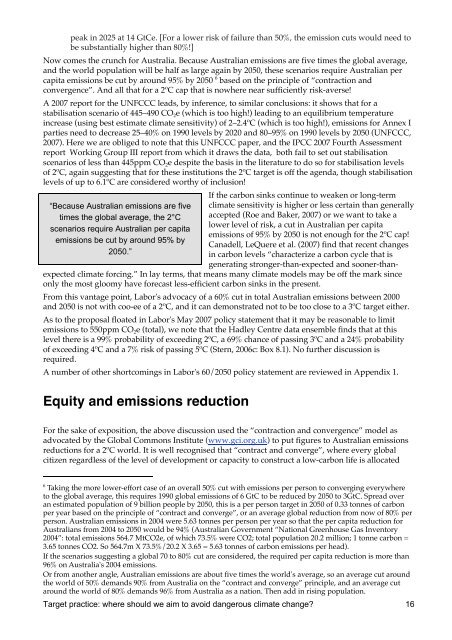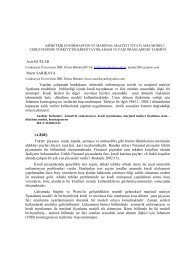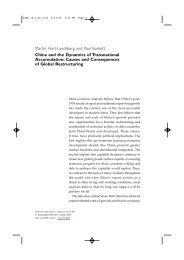where should we aim to prevent dangerous climate change?
where should we aim to prevent dangerous climate change?
where should we aim to prevent dangerous climate change?
Create successful ePaper yourself
Turn your PDF publications into a flip-book with our unique Google optimized e-Paper software.
peak in 2025 at 14 GtCe. [For a lo<strong>we</strong>r risk of failure than 50%, the emission cuts would need <strong>to</strong>be substantially higher than 80%!]Now comes the crunch for Australia. Because Australian emissions are five times the global average,and the world population will be half as large again by 2050, these scenarios require Australian percapita emissions be cut by around 95% by 2050 6 based on the principle of “contraction andconvergence”. And all that for a 2ºC cap that is no<strong>where</strong> near sufficiently risk-averse!A 2007 report for the UNFCCC leads, by inference, <strong>to</strong> similar conclusions: it shows that for astabilisation scenario of 445–490 CO 2 e (which is <strong>to</strong>o high!) leading <strong>to</strong> an equilibrium temperatureincrease (using best estimate <strong>climate</strong> sensitivity) of 2–2.4ºC (which is <strong>to</strong>o high!), emissions for Annex Iparties need <strong>to</strong> decrease 25–40% on 1990 levels by 2020 and 80–95% on 1990 levels by 2050 (UNFCCC,2007). Here <strong>we</strong> are obliged <strong>to</strong> note that this UNFCCC paper, and the IPCC 2007 Fourth Assessmentreport Working Group III report from which it draws the data, both fail <strong>to</strong> set out stabilisationscenarios of less than 445ppm CO 2 e despite the basis in the literature <strong>to</strong> do so for stabilisation levelsof 2ºC, again suggesting that for these institutions the 2ºC target is off the agenda, though stabilisationlevels of up <strong>to</strong> 6.1ºC are considered worthy of inclusion!“Because Australian emissions are fivetimes the global average, the 2°Cscenarios require Australian per capitaemissions be cut by around 95% by2050.”If the carbon sinks continue <strong>to</strong> <strong>we</strong>aken or long-term<strong>climate</strong> sensitivity is higher or less certain than generallyaccepted (Roe and Baker, 2007) or <strong>we</strong> want <strong>to</strong> take alo<strong>we</strong>r level of risk, a cut in Australian per capitaemissions of 95% by 2050 is not enough for the 2ºC cap!Canadell, LeQuere et al. (2007) find that recent <strong>change</strong>sin carbon levels “characterize a carbon cycle that isgenerating stronger-than-expected and sooner-thanexpected<strong>climate</strong> forcing.” In lay terms, that means many <strong>climate</strong> models may be off the mark sinceonly the most gloomy have forecast less-efficient carbon sinks in the present.From this vantage point, Labor's advocacy of a 60% cut in <strong>to</strong>tal Australian emissions bet<strong>we</strong>en 2000and 2050 is not with coo-ee of a 2ºC, and it can demonstrated not <strong>to</strong> be <strong>to</strong>o close <strong>to</strong> a 3ºC target either.As <strong>to</strong> the proposal floated in Labor's May 2007 policy statement that it may be reasonable <strong>to</strong> limitemissions <strong>to</strong> 550ppm CO 2 e (<strong>to</strong>tal), <strong>we</strong> note that the Hadley Centre data ensemble finds that at thislevel there is a 99% probability of exceeding 2ºC, a 69% chance of passing 3ºC and a 24% probabilityof exceeding 4ºC and a 7% risk of passing 5ºC (Stern, 2006c: Box 8.1). No further discussion isrequired.A number of other shortcomings in Labor's 60/2050 policy statement are revie<strong>we</strong>d in Appendix 1.Equity and emissions reductionFor the sake of exposition, the above discussion used the “contraction and convergence” model asadvocated by the Global Commons Institute (www.gci.org.uk) <strong>to</strong> put figures <strong>to</strong> Australian emissionsreductions for a 2ºC world. It is <strong>we</strong>ll recognised that “contract and converge”, <strong>where</strong> every globalcitizen regardless of the level of development or capacity <strong>to</strong> construct a low-carbon life is allocated6 Taking the more lo<strong>we</strong>r-effort case of an overall 50% cut with emissions per person <strong>to</strong> converging every<strong>where</strong><strong>to</strong> the global average, this requires 1990 global emissions of 6 GtC <strong>to</strong> be reduced by 2050 <strong>to</strong> 3GtC. Spread overan estimated population of 9 billion people by 2050, this is a per person target in 2050 of 0.33 <strong>to</strong>nnes of carbonper year based on the principle of “contract and converge”, or an average global reduction from now of 80% perperson. Australian emissions in 2004 <strong>we</strong>re 5.63 <strong>to</strong>nnes per person per year so that the per capita reduction forAustralians from 2004 <strong>to</strong> 2050 would be 94% (Australian Government “National Greenhouse Gas Inven<strong>to</strong>ry2004”: <strong>to</strong>tal emissions 564.7 MtCO2e, of which 73.5% <strong>we</strong>re CO2; <strong>to</strong>tal population 20.2 million; 1 <strong>to</strong>nne carbon =3.65 <strong>to</strong>nnes CO2. So 564.7m X 73.5%/20.2 X 3.65 = 5.63 <strong>to</strong>nnes of carbon emissions per head).If the scenarios suggesting a global 70 <strong>to</strong> 80% cut are considered, the required per capita reduction is more than96% on Australia's 2004 emissions.Or from another angle, Australian emissions are about five times the world's average, so an average cut aroundthe world of 50% demands 90% from Australia on the “contract and converge” principle, and an average cutaround the world of 80% demands 96% from Australia as a nation. Then add in rising population.Target practice: <strong>where</strong> <strong>should</strong> <strong>we</strong> <strong>aim</strong> <strong>to</strong> avoid <strong>dangerous</strong> <strong>climate</strong> <strong>change</strong>? 16





